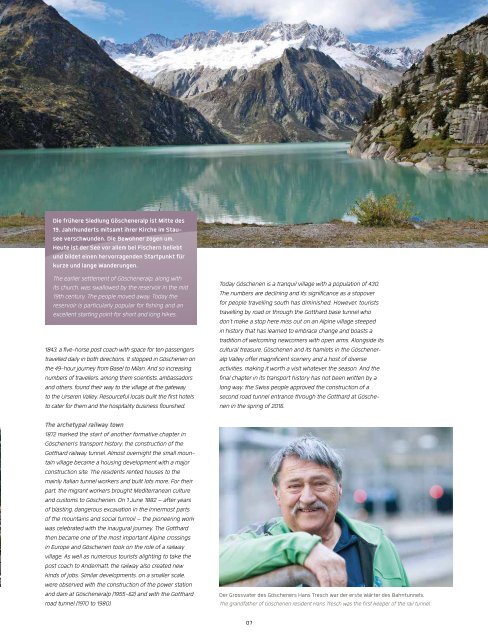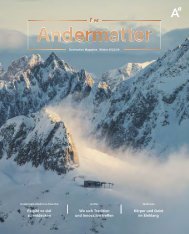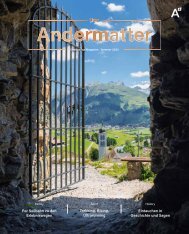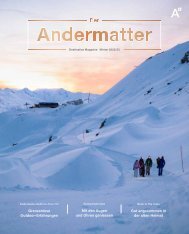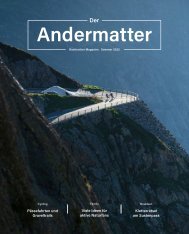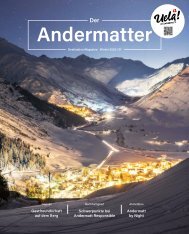Sie wollen auch ein ePaper? Erhöhen Sie die Reichweite Ihrer Titel.
YUMPU macht aus Druck-PDFs automatisch weboptimierte ePaper, die Google liebt.
Die frühere Siedlung Göscheneralp ist Mitte des<br />
19. Jahrhunderts mitsamt ihrer Kirche im Stausee<br />
verschwunden. Die Bewohner zogen um.<br />
Heute ist der See vor allem bei Fischern beliebt<br />
und bildet einen hervorragenden Startpunkt für<br />
kurze und lange Wanderungen.<br />
The earlier settlement of Göscheneralp, along with<br />
its church, was swallowed by the reservoir in the mid<br />
19th century. The people moved away. Today the<br />
reservoir is particularly popular for fishing and an<br />
excellent starting point for short and long hikes.<br />
1843, a five-horse post coach with space for ten passengers<br />
travelled daily in both directions. It stopped in Göschenen on<br />
the 49-hour journey from Basel to Milan. And so increasing<br />
numbers of travellers, among them scientists, ambassadors<br />
and others, found their way to the village at the gateway<br />
to the Urseren Valley. Resourceful locals built the first hotels<br />
to cater for them and the hospitality business flourished.<br />
The archetypal railway town<br />
1872 marked the start of another formative chapter in<br />
Göschenen's transport history: the construction of the<br />
Gotthard railway tunnel. Almost overnight the small mountain<br />
village became a housing development with a major<br />
construction site. The residents rented houses to the<br />
mainly Italian tunnel workers and built lots more. For their<br />
part, the migrant workers brought Mediterranean culture<br />
and customs to Göschenen. On 1 June 1882 – after years<br />
of blasting, dangerous excavation in the innermost parts<br />
of the mountains and social turmoil – the pioneering work<br />
was celebrated with the inaugural journey. The Gotthard<br />
then became one of the most important Alpine crossings<br />
in Europe and Göschenen took on the role of a railway<br />
village. As well as numerous tourists alighting to take the<br />
post coach to Andermatt, the railway also created new<br />
kinds of jobs. Similar developments, on a smaller scale,<br />
were observed with the construction of the power station<br />
and dam at Göscheneralp (1955-62) and with the Gotthard<br />
road tunnel (1970 to 1980).<br />
Today Göschenen is a tranquil village with a population of 430.<br />
The numbers are declining and its significance as a stopover<br />
for people travelling south has diminished. However, tourists<br />
travelling by road or through the Gotthard base tunnel who<br />
don’t make a stop here miss out on an Alpine village steeped<br />
in history that has learned to embrace change and boasts a<br />
tradition of welcoming newcomers with open arms. Alongside its<br />
cultural treasure, Göschenen and its hamlets in the Göscheneralp<br />
Valley offer magnificent scenery and a host of diverse<br />
activities, making it worth a visit whatever the season. And the<br />
final chapter in its transport history has not been written by a<br />
long way: the Swiss people approved the construction of a<br />
second road tunnel entrance through the Gotthard at Göschenen<br />
in the spring of 2016.<br />
Der Grossvater des Göscheners Hans Tresch war der erste Wärter des Bahntunnels.<br />
The grandfather of Göschenen resident Hans Tresch was the first keeper of the rail tunnel.<br />
07


